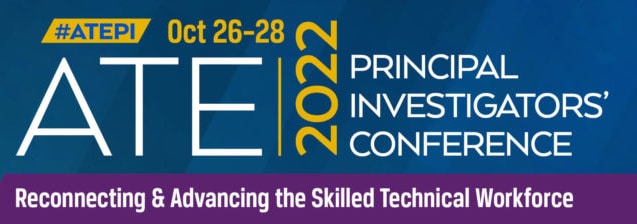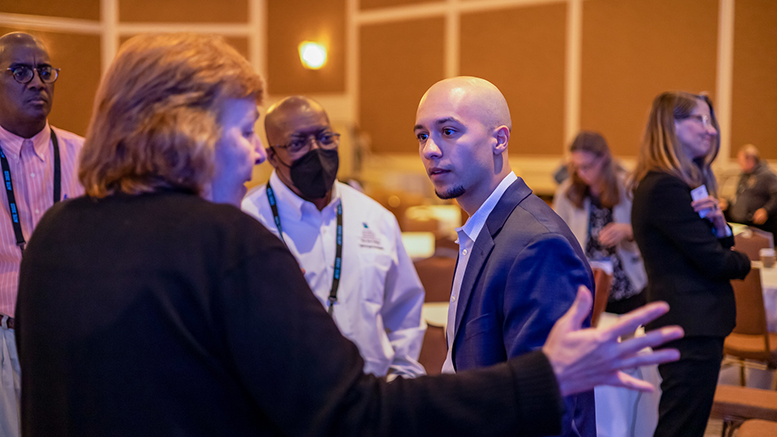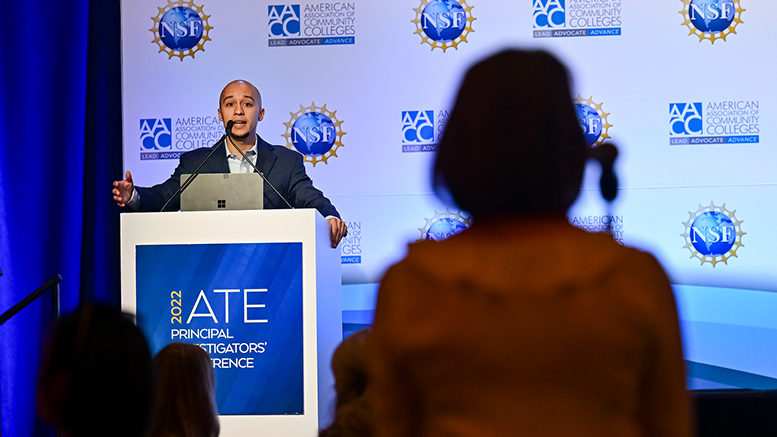Everything about Zach Oxendine exudes energy and purpose. One of seven children born to deaf parents in rural South Carolina and a member of the Lumbee tribe of Native Americans, he charted his own path to success with a two-year degree and a stint in the U.S. Air Force.

Today, Oxendine works at his dream job as a service engineer at Microsoft and is giving back to his community by hosting a STEM summer camp for indigenous Americans and others living in rural areas. He said he hopes he can expose youth to the opportunities community colleges offer to prepare them for successful careers.
“I hope you guys go back to your communities – and regardless if it’s cybersecurity or any other program that you are involved in – tell these kids that folks like myself exist and there are a lot more people where we come from,” he told those gathered for a plenary session at the 2022 Advanced Technological Education (ATE) Principal Investigators’ Conference last week.
“If they have the grit and determination and just some mentorship, the opportunities are endless,” he added.
The American Association of Community Colleges (AACC) hosted the three-day meeting in Washington, D.C., in partnership with and the support of the National Science Foundation (NSF). Several hundred educators and 42 students and some industry partners of the ATE grant-funded initiatives attended the conference to share information about their innovations.
Part of ATE’s mission is to grow and broaden the diversity of the skilled technical workforce. To that end, it has supported efforts to recruit and educate historically underrepresented populations for careers in advanced STEM technology fields.
How faculty can help
After completing 4½ years in the Air Force where he worked in cybersecurity operations, Oxendine landed his dream job at Microsoft last year. Observing colleagues with “all these big degrees,” he said he soon realized “they don’t know anything more than I do.”
Oxendine advocates for community colleges and other two-year programs that can be game-changers in helping youth get the education they need and closing the gap in today’s workforce.
He urged those gathered to press for passage of the National Community College Cybersecurity Challenge Act, federal legislation introduced in September. (See sidebar)

During a panel discussion at the conference, two community college professors who are principal investigators of ATE project grants said there is much faculty can do to help students from underrepresented populations persist in their courses.
“Professors should know their students and understand the unique challenges underrepresented minority students face… It’s important for faculty to understand that to help retain them in the classroom,” said Juan Rodriguez, Jr., a cybersecurity professor at New York’s Westchester Community College (WCC), during a session that focused on helping underrepresented minorities in cybersecurity.
Rodriguez, is the principal investigator of the HSI ATE Hub 2: Culturally Responsive Technician Education project at WCC. It is testing the asset-oriented pedagogy developed by researchers at Arizona State University’s Center for Broadening Participation in STEM. Rodriquez has described the approach as boiling down to being attentive to students’ needs.
Rodriguez explained that when a top-performing student suddenly stopped turning in her work on time, he called her and learned she was on a volleyball scholarship that infringed on her studies.
“We have to look at our students as individuals. A lot of them want help, they’re just afraid to ask,” Rodriguez added. “A lot of our first-generation students have so many things to worry about. I know because I was one of them.”
Connecting with students
Faculty whose backgrounds are similar to their students should share their stories with them “so the students can see themselves in you or relate to you,” said Diego Tibaquirá, a computer science professor at the Eduardo J. Padrón Campus of Florida’s Miami Dade College (MDC).
Tibaquirá’s first ATE grant was for Cybersecurity Opportunities and Methods that Promote Access and Student Success (COMPASS) project. It created a cybersecurity associate degree program that incorporates industry credentials and a cybersecurity boot camp to recruit high school students. The faculty members involved in the project boosted their professional skills by earning 11 industry credentials. In addition to their college courses, the Miami Dade faculty have taught cybersecurity workshops to high school educators. The COMPASS project accomplished so much so quickly that it led to MDC’s selection as EC-Council Best New Comer Award in 2019.
Most of the several hundred students who have taken cybersecurity courses at MDC since COMPASS started the program in 2018 are from populations historically underrepresented in STEM fields. Because preparation for industry certification exams is woven into every cybersecurity course (industry certification exams serve as the final exam in many courses) students have the potential to earn industry credentials sought by the region’s employers along with college credits toward degrees. A portion of the $223,928 ATE grant for COMPASS was used to pay students’ fees for industry certification exams.
As a veteran, Tibaquirá has also organized programs that reach out to students who previously served in the military. He told the conference attendees that faculty should understand the challenges their students face and avoid setting unreasonable demands that could prompt a student to drop out.
“They have had a lot of doors slammed in their faces and you do that once more…it can drive a person away,” he said.
Other factors that Rodriguez and Tibaquirá identified to help recruit and retain underrepresented populations include ensuring the college dean, faculty and other stakeholders are committed to targeted programs; partnering with high schools to set up a pipeline for future enrollment of underrepresented populations; and ensuring faculty are current in their professional development.




